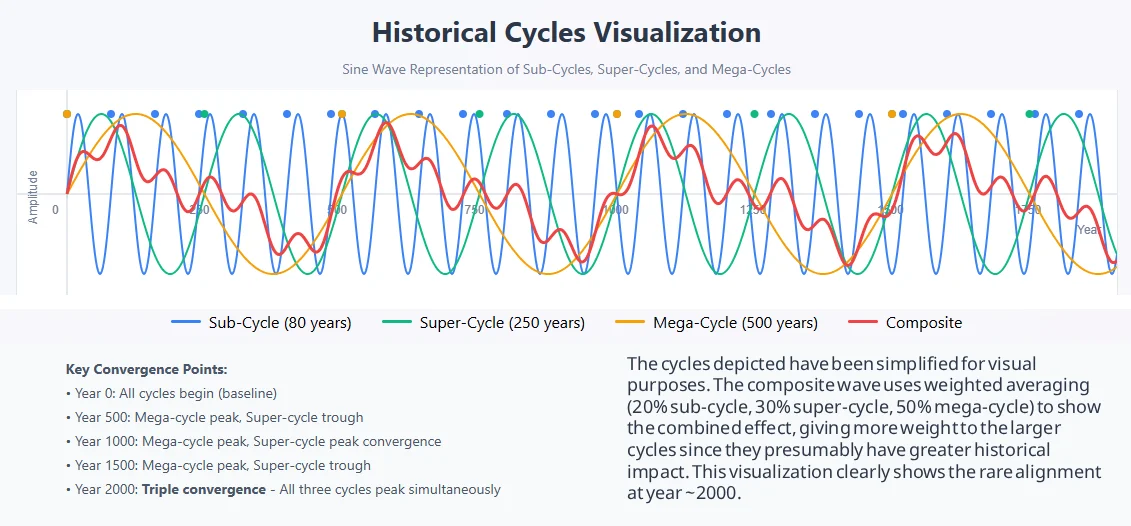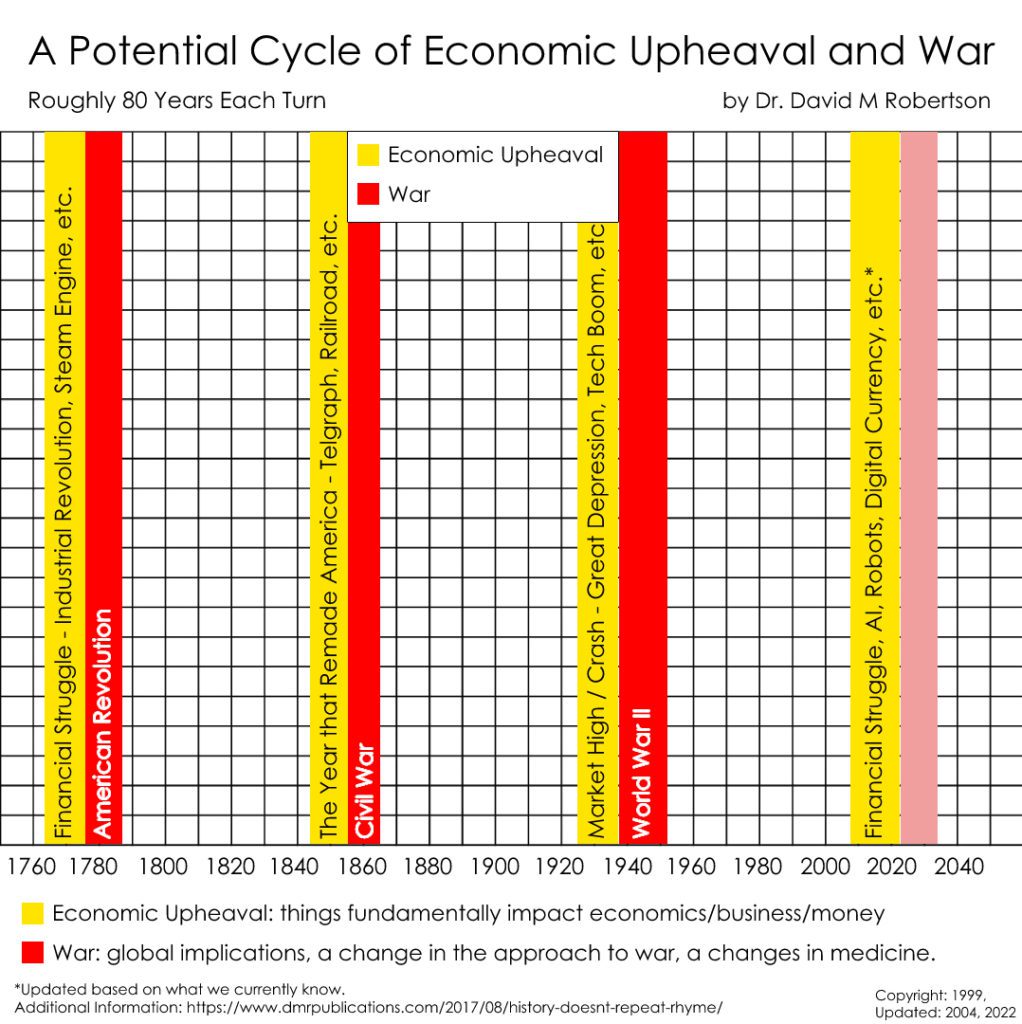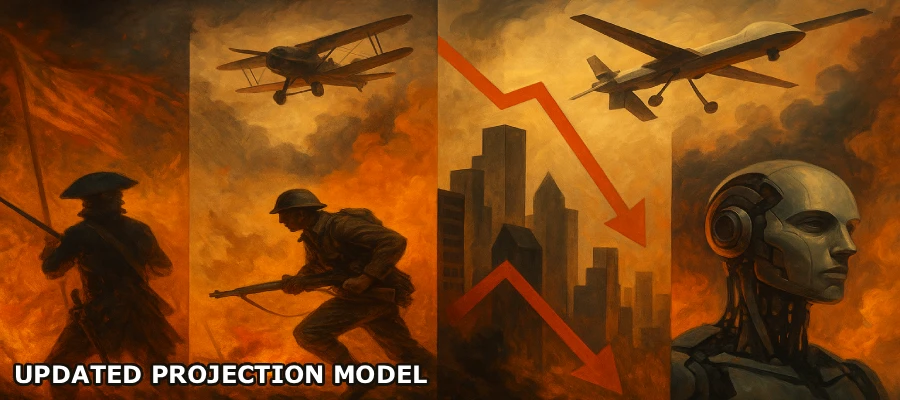America’s Terminal Cycle and the Path to Escape
Do you ever get the feeling that civilizations do not rise and fall randomly? You might be right. History demonstrates that dominant powers endure for roughly two and a half centuries before their primacy fades. What if America’s terminal cycle is real? What if it is already here?
The Dutch commercial-finance order of the 1600s lasted about 250 years before it collapsed under debt and war, yielding to Britain. Britain’s industrial-financial empire then carried the mantle for about the same duration before it was exhausted by two world wars and supplanted by the United States. America, born in 1776, is now at the same age. Its power was built on constitutional governance, industrial strength, the dollar as global reserve, and unmatched military capability. Yet it now displays the same late-stage markers: staggering debt, military overextension, institutional capture, currency challenge, and internal fracture.
Alongside the super-cycle of roughly 250 years, the United States has also followed shorter internal sub-cycles of upheaval, war, and reset. The first brought revolution and a founding reset. The second brought the Civil War and federal consolidation. The third brought the Great Depression, World War II, and the Bretton Woods order. The fourth began with the global financial crisis of 2008, has moved into a hybrid war phase since 2014, and is now barreling toward a resolution window between 2025 and 2033. Each of these sub-cycles follows a rhythm: decades of expansion and complacency, about a decade of upheaval, and about a decade of war that forces a systemic reset.
The Continuity of Overlapping Empires
The pattern of roughly 250 years is clear, but it is also important to recognize that empires overlap rather than pass the mantle cleanly. The Dutch order did not vanish when Britain rose; Dutch banking and trade networks persisted even as Britain eclipsed them. Britain remained powerful long after the United States had surpassed it financially and militarily, still exerting influence through language, law, and alliances. America may very-well follow the same path. It likely will not disappear, but the unique position of setting the global rules and holding the reserve currency is already contested. Overlap is the normal pattern of transfer. Recognizing this helps explain why the present feels ambiguous: decline and rise happen simultaneously, often stretching across decades.
The Hallmarks of Upheaval and War
The signatures of these phases are consistent. Economic upheaval is always marked by a transformation in how the world conducts its business. In the eighteenth century, it was the rise of steam and factories. In the nineteenth century, it was railroads and telegraphs. In the twentieth century, it was mass electrification, industrial consolidation, and global corporations. Today, it is the digital transformation: artificial intelligence, cryptocurrency, supply chain automation, and new settlement systems that bypass the dollar.
The war phase is similarly consistent, though its form evolves. In one cycle, the change was from militias to line armies. In another, it was the mobilization of railroads and telegraphs to sustain total war. Later, it was mechanized warfare and nuclear weapons. Today, it is cyber operations, drones, autonomous targeting systems, the militarization of space, and the full weaponization of information. War marks not only destruction, but also a step-change in how conflict is conducted. Medicine and science accelerate as well, often maturing under the pressure of war before reshaping postwar society.
Why People Do Not Recognize the Present as War
One of the most dangerous illusions today is the belief that the war phase has not yet arrived. Many expect it to look like the Civil War or World War II, with mass mobilization and open declarations. Yet the present war began a decade ago, not with cannon fire but with hybrid campaigns. Cyber intrusions, disinformation, assassinations, proxy militias, ransomware attacks, Active Measures, Reflexive Control, and shipping disruptions are the battlefields of today. It’s Fifth Generation Warfare.
The inability to recognize this stems from several reinforcing factors. Language has been weaponized to control perception. Labels such as “extremist,” “racist,” “fascist,“ “Nazi,“ or “conspiracy theorist” are not used to advance debate but to shut it down, to stigmatize dissent, and to induce self-censorship. This is dangerous because a population conditioned to fear labels learns not to question. Years of overlapping crises and contradictory messaging have also produced a form of learned helplessness. This is no accident. People feel powerless to change outcomes, and this passivity increases compliance.
Mass epistemic rigidity compounds the problem. Groups cling to rigid narratives even as evidence shifts. Motivated reasoning, authority bias, and echo chambers reward loyalty to the story over fidelity to truth. Contradictions in logic go unchecked and unchallenged. This rigidity is a vulnerability that adversaries exploit through Active Measures and Reflexive Control.
Oversight failures deepen the spiral. Revolving doors between corporations, banks, and government agencies reduce accountability and concentrate power. Poor education systems ensure that foundational values erode as fewer citizens understand constitutional principles, making substitution with newly promoted values easier. Crises are manipulated to accelerate structural changes that would never survive debate in calmer times, and temporary emergency measures quietly become permanent.
Emotion drives bias. You are the target in this operation. The result is a society already in a war phase, but unable to name it. Some cannot see or even refuse to see it. Regardless, this blindness delays adaptation and magnifies risk. The outcomes is predictable. Meanwhile, those who could make a difference remain on the sidelines due to a strong fear of the consequences of stepping up.
The Global and Domestic Theaters
In my opinion, the shape of the conflict is visible if one is willing to see. The blocs are clear. The United States, NATO, Japan, South Korea, Australia, and Israel form one side. Russia, China, Iran, North Korea, Venezuela, and Cuba anchor the other, with states like India, Saudi Arabia, and Turkey attempting to hedge but slowly drifting toward one side or the other. When I first spoke of these blocs, most were in denial. Today, many still are.
Of course, the theaters of confrontation are also defined. In Europe, Russian drones have already triggered Poland to invoke NATO’s Article 4. In the Middle East, Iran has already launched directly against Israel, moving beyond proxy war into overt state action. In Asia, the South China Sea and Taiwan remain flashpoints where daily pressure events increase the chance of miscalculation. In Latin America, Venezuela and a cartel-driven hybrid conflict erode U.S. stability from the south. In the Arctic, competition over resources and routes draws Russia and China into a sharper contest with the United States.
Within the United States itself, internal legitimacy shocks, targeted political violence, mass migration, and contested state-federal authority weaken cohesion and create openings for adversaries. Federalism is on the rise in direct opposition to the Bill of Rights. Of course, most wouldn’t understand that because that lesson was either taught at a very early age, or simply never covered. Ideological Subversion is real and has already infected our nation. We are watching the divide widen by the day and the risk of civil rupture within the United States seems higher than it has been at any point since the 1860s.
America’s Terminal Cycle: The Refined Timeline
Indeed, there are several ways this model can be approached. However, the cleanest way to mark the present cycle is to begin the upheaval with the global financial crisis of 2008, but recognize that even that had a bunch of working parts that are hard to nail down. Nonetheless, the years that followed were a decade of upheaval marked by debt expansion, quantitative easing, and accelerating digital transformation.
The war phase is even harder to pin down due to the ambiguous nature of Fifth Generation Warfare, but it could be argued that it opened quietly in 2014 with Crimea, ISIS, and intensified cyber operations. Escalation has grown steadily through the 2020s, with Ukraine, Israel-Iran direct exchanges, and NATO’s invocation of Article 4 as undeniable markers.
Taken together, the resolution window seems to be between 2025 to 2033. Having crunched the numbers numerous times, that is consistent with the timing of America’s sub-cycles and with the broader convergence of the 250-year super-cycle. And that is actually the bigger problem. I have come to the conclusion that pinning this down has been difficult because the fourth sub-cycles are very messy, and the convergence of other cycles merely exacerbate the complexity.
Either way, Americans don’t have much time to prepare if they are currently unprepared for a disaster. Even those who think they are prepared might find themselves facing something they could not have imagined. Most will deny their reality until the last second anyway.
The Messy Fourth Sub-Cycle at Super-Cycle End
As alluded to, one interesting observation has me quite concerned, and this is an important clarification. When a sub-cycle collides with the close of a super-cycle, the boundaries blur. The Dutch Republic’s fourth sub-cycle did not resolve into a single clear upheaval-war-reset. It became a long bleed of overlapping wars, financial hollowing, and eventual collapse into Napoleonic structures. Britain’s fourth sub-cycle was similar. Its upheaval was murky, its wars came as two global conflagrations rather than one, and its reset was drawn out through currency collapse, decolonization, and gradual loss of primacy to the United States.
Unfortunately, America’s fourth sub-cycle shows the same turbulence. The upheaval after 2008 did not really stabilize, and few learned the lesson. Hybrid war began as early as 2014 but lacked a clean declaration. The escalation of the 2020s is less a singular event and more a cascade of overlapping confrontations from numerous actors. The resolution will likely be messy because the system is not only completing another turn but also closing the 250-year American super-cycle and aligning with a Mega-Cycle. This is not good at all. Match that with a complete loss of national identity, and you have a nation filled with confused and indoctrinated people who have no idea what they might try to protect or defend in the first place.
Cycle overlaps merely add to the confusion. As with Britain and the Dutch, America may not vanish when the cycle turns. Its institutions could persist. However, the mantle of global reserve and order-setting authority is likely to transfer unevenly, with years of contested overlap before consolidation. That’s the best-case scenario. The worst case scenario is probably a total collapse due to the loss of national loyalties and drive. The most the likely scenario is somewhere in between.
I have come to realize that the messiness of the fourth sub-cycle is not a flaw in the model. It is a sign of things to come. It is the expected signature of a system reaching the end of both a sub-cycle and a super-cycle at the same time. That is scary in and of itself, but as previously mentioned, the bigger concern for me is the potential merger of the “Mega Cycle.” All we have to do is examine the tripwires to measure progression.
Why This Time May Be Worse Than Before
I’ll begin by saying that we don’t know what we don’t know. So, while historical cycles provide the framework, several factors could compress or intensify the traditional timing. Technological acceleration represents the most significant variable. Artificial intelligence, quantum computing, and synthetic biology are advancing at exponential rather than linear rates, potentially compressing decades of change into years, and years into months. The AI revolution alone could trigger economic disruptions that historically took generations to unfold. Some might argue that it already is. Sure, previous cycles saw technology as an enabler of change, but this cycle may see technology as the primary driver, fundamentally altering the 80-year generational rhythm that has held for as far back as I care to look.
Economic indicators flash warnings beyond historical precedent. U.S. debt-to-GDP has exceeded 120%, surpassing World War II levels without the excuse of global conflict. The BRICS+ coalition now represents 37% of global GDP and is actively developing alternatives to SWIFT and dollar settlement. Many nations are trying to abandon the dollar (dedollarization). The dollar has lost over 97% of its value since 1912. Central bank digital currencies (CBDCs) are being tested by 134 countries, representing 98% of global GDP and a coordinated move away from traditional monetary systems that took centuries to establish. I could go on but these are not gradual transitions. These are accelerating breaks from the post-Bretton Woods order, suggesting the economic foundation of the super-cycle is fracturing faster than historical patterns would predict.
Another issue that many are simply unaware of, is the demographic collapse. This presents an unprecedented wildcard that may fundamentally alter the mega-cycle itself. You need to understand that every developed nation now faces below-replacement birth rates, with some approaching one child per woman, which is half the rate needed for stability. China’s population peaked in 2022 and will likely halve by 2100. From what we currently understand, this has never occurred during previous mega-cycles. For example, Rome fell amid population growth, and the Renaissance began during demographic expansion. This is highly unusual.
Understand that we are witnessing the first civilizational transition during voluntary demographic contraction. This will create unreal tension and stress. It already has. You may not be informed about this threat at the moment because mass migration efforts temporarily mask this. However, such efforts also create its own instabilities, as seen in Europe and the United States. The result may be a mega-cycle that does not transfer power to a rising civilization but rather sees global contraction, which will be a truly unprecedented outcome.
Resource constraints add another critical layer of systemic pressure absent from previous cycles. Peak phosphorus for fertilizer, water table depletion, soil degradation, and fishery collapse converge in the 2025-2035 window. Peak food, forever chemicals, microplastics, and pesticides, just make it worse. The saddest part is that most of our issues are self-inflicted, but there is no place to retreat.
Previous empires could expand into virgin territories or exploit new colonies when resources dwindled. Today’s powers face a closed system where resource competition becomes zero-sum. You are already seeing the clues of what happens. Food insecurity already affects 2.4 billion people globally. When China imports 70% of its soybeans and the Middle East imports 90% of its grain, agricultural disruption becomes a catalyst for conflict.
The easiest example is probably the Arab Spring, which actually began with wheat prices. The next upheaval may start with a broader food system failure that no single empire can escape. Add in the growing divide between the limited availability of ancestral nutrition and the saturation of industrial food systems, and the picture becomes even more complex. After all, if you cannot find or consume food to sustain health, you have a big problem on your hands.
Of course, each cycle manifests through the technologies and contexts of its era, making precise pattern recognition challenging in real-time. Where the Civil War cycle leveraged railroads and telegraphs, and World War II deployed mechanized warfare and radio, our current cycle weaponizes algorithms, satellites, and synthetic biology. The very nature of disruption evolves. This is to say that we may be living through epoch-defining ruptures that appear to us as isolated crises: a pandemic here, a financial crisis there, a social media revolution, supply chain collapses. Only in hindsight do these seemingly disconnected events reveal themselves as part of the same historical convulsion. The challenge is not that cycles don’t repeat, but that they rhyme in frequencies we haven’t yet learned to hear. By the time we recognize the pattern, we’re often already trapped within it.
(Dropdown) The Mega-Cycle
When All Gears Align
If the smaller cycles are true, then larger cycles must exist as well, just as a machine functions because its smaller gears drive the larger ones. From what I can tell, the 80-year sub-cycles of upheaval, war, and reset sit inside the 250-year super-cycle of national or imperial ascendancy. However, something I recently found is that the super-cycle appears to sit inside a civilizational wave lasting roughly 500 years. These are neither good nor bad; they just are. And when all three converge at either an endpoint or a beginning, the result is what I am calling a Mega Cycle.
Indeed, this is speculative, and I hope other strategists and historians will explore this, but from what I can tell, this has happened twice in the last two millennia. The fall of Rome illustrates the last mega-cycle ending. Now, we can know this because the collapse struck not only Rome but also Han China, Teotihuacan in Mesoamerica, and other advanced states. The result was not merely one empire’s decline but a civilizational contraction. The falls was marked by knowledge loss, fractured trade, and centuries of regression. Of course, this resulted in the “Dark Ages.” However, the so-called Dark Ages were not unique to Europe, because it reflected a global downturn that marked the end of a mega-cycle.
That said, the Scottish Enlightenment shows us the beginning of the last mega-cycle. In the 1600s and 1700s, new thinking in science, philosophy, and governance combined with commercial and constitutional revolutions to launch the modern era. The Enlightenment did not simply empower new empires; it reset civilization itself. The Dutch, British, and American orders were successive strokes within that rising tide.
The present moment appears to be another mega-cycle convergence. The United States’ 250-year super-cycle is closing. The ~80-year sub-cycle is entering its war/reset phase, with the 2025–2033 window marking its peak danger. And the ~500-year modern civilizational wave that began with the Renaissance and Enlightenment is now at maturity after centuries of ascent. When sub-cycle, super-cycle, and civilizational wave converge, the machine reaches its most unstable point. Let’s detail this out.
- Sub-cycles (~80 years): Revolutionary reset, Civil War reset, WWII reset, current upheaval/war phase (2008–2033).
- Super-cycle (~250 years): America’s rise 1776–2025/33.
- Civilizational wave (~500 years): Began with the Renaissance/Enlightenment (1400s–1700s), now maturing in the 2000s–2100s.
- Mega Cycle (~500–600 years): When sub-cycle, super-cycle, and civilizational wave crest together.
For the sake of time, space, and sanity, I’m going to simplify the Mega Cycle so you can see what I am trying to convey without getting too far into the weeds.
Simplistic Observation/Theory:
- The ~500-year waves mapped onto major civilizational transitions:
- 0 → ~500 CE (Fall of Rome & global contractions).
- 500 → 1000 CE (Medieval consolidation).
- 1000 → 1500 CE (Renaissance transition).
- 1500 → 2000 CE (Enlightenment to American order).
- 2000 → 2500 CE (Global contraction – or – Tech-based transition?)
- Each wave contains 250-year “super-cycles” of dominant powers (Dutch, British, American), and sub-cycles of civilizational norms.
- The current moment (2000–~2050) looks like the convergence point: a civilizational mega-cycle crest overlapping with America’s 250-year super-cycle and the 80-year sub-cycle.

Yes, I could be wrong, but this alignment implies that what we face is not just a national or imperial transition but a potential civilizational rupture. I am even remotely accurate in this assessment, then the risks are greater than a transfer of primacy from the United States to China or BRICS. They include the possibility of a regression at the scale of Rome’s fall, with global systems collapsing together. At this point, I should probably clarify that while empires overlap in their transfers of primacy, when cycles converge into a mega-cycle, the overlap still masks a deeper reset in how civilization itself is organized.
Yet within this model also lies a clue. Machines function because their gears lock together, but gears can also be disrupted. If sub-cycles repeat because of recurring human biases and leadership failures, then perhaps non-biased intervention at the smaller scale could eventually prevent the larger collapses. In my opinion, recognizing (and accepting) the nested structure (sub-cycle within super-cycle within mega-cycle) is the first step. Even if our generation cannot escape the pattern, leaving a clear map of how the gears aligned may provide future generations with the chance to finally break free of the machine.
What We Have Already Seen
I believe the warning signs are staring us in the face. Several of the tripwires that normally mark a shift from hybrid conflict to open rupture have already been crossed. NATO’s Article 4 has been invoked. Iran has already launched a direct attack on Israel. Mass migration has already become a destabilizing shock in Western nations. Political assassinations have been both attempted and successful. Western nations are imploding, and turning on themselves (like England). The list goes on, but these are not theoretical markers; they are present realities.
Other indicators remain amber, including the risk of a Taiwan clash, entitlement insolvency, sovereign debt crisis, state nullification, and tier-one cyber or space warfare events. But the fact that multiple tripwires have already fired, and more are on a razor’s edge means that we are not waiting for the war phase to begin. We are already in it, and this sentiment has been echoed by experts, generals, and media for the last several years. Of course, I have written about the math before, so let’s focus on the here and now. Examine the following graph, which represents the American cycle, and note the timeline regarding conflict.

Strategic Forecast: 2025–2033
If this analysis is accurate, then we are now midway through the final turn. However, if the math is correct, and if the fourth sub-cycle is merging with the 250-year super-cycle and the 500-year Mega-Cycle, the most dangerous years are likely to be 2025 to 2029, when internal legitimacy crises and external confrontation converge. For example, a constitutional crisis at home combined with a kinetic clash abroad would produce conditions for systemic rupture that could cascade globally. Of course, that potential seems to be increasing by the day.
Using the three-rule method, it seems to me that about three families of outcomes are plausible. One is the reconstitution of the United States, though this would require immense fiscal repair, hardened infrastructure, a renewed sense of foundational values, civic renewal, currency improvements, banking reform and restructuring, and restored legitimacy. Another is a multipolar reset in which the dollar remains important but likely diminished, with BRICS and other blocs consolidating alternative systems. The third is total fragmentation, where domestic rupture prevents coherent participation and external actors inherit the mantle.
It is hard to say exactly how this will play out. However, remember that the last time the three cycles converged was when Rome (and the rest of the planet) fell. Are we are looking down the barrel of a total reset? I do not know, but again, this reset is scheduled to arrive within the 2025–2033 window, and things sure appear to be pointed that in direction. Probably best to be prepared, just in case.
Breaking the Cycle: Toward Escape Velocity
This work began with the question of whether the cycles are real. After over 25 years of study on the matter, I think the evidence demonstrates that they are. But the deeper question is whether they can be broken. Will the U.S. decline? Will there be civilizational collapse? These are scary questions.
Some might suggest that it is merely the cycle of empires, but it seems to me that cycles repeat because human cognition repeats. As the 3B Model demonstrates: emotion drives bias; bias drives belief; belief drives behavior; behavior drives outcomes. This chain locks us into predictable mistakes. Epistemic rigidity ensures that groups cling to narratives even when false, rendering them incapable of changing their minds. Adversaries exploit these tendencies through psyops and Reflexive Control. Safety is mistaken for stability, and the pursuit of safety breeds fragility and decline. It’s predictable, but far too many consider themselves too smart or too strong to succumb. However, the phrase “History repeats” exists because breaking free is easier said than done.
In my opinion, the path to escape begins with Contrastive Inquiry, because the key is literally in the contrast. However, we must also embrace adversity and reject safety. Societies that embrace adversity build capacity. Those who avoid hardship lose agility. Our Founders knew this. At the Pennsylvania Assembly, Benjamin Franklin replied to the Governor (11 November 1755) by saying “They who can give up essential liberty to obtain a little temporary safety, deserve neither liberty nor safety.” Thomas Jefferson wrote a letter to James Madison, on January 30, 1787. The full Latin phrase he used was “Malo periculosam libertatem quam quietam servitutem,” and fancy way to say “I prefer dangerous freedom over peaceful slavery.” Interestingly, these quotes parallel the sentiments of Roman historian and politician Publius Cornelius Tacitus (AD 56 to AD 120) who said that “The desire for safety stands against every great and noble enterprise.”
We may never learn, but the truth is that, to adapt, we must reframe adversity as essential training rather than something to be avoided. Contrastive Inquiry merely provides us with the practical tool to break rigidity. By forcing the mind to hold opposing explanations, examine evidence, and change conclusions when necessary, it prevents ossification. The 3B Model along with contrastive inquiry adds to our cognitive defense, teaching citizens to detect emotional manipulation before it cascades into destructive belief and behavior.
This might seem complicated, but essentially, breaking the cycle requires civic literacy, resilience training, media forensics, and an embrace of adversity at scale. Without these, the cycle will complete as it always has. However, if we can embrace these ideas, there is at least a chance of bending it for the first time.
Why Critics Dismissed and Why the Forecast Holds
When I first advanced these arguments in 1999, critics accused me of alarmism or suggested that because I was young, I simply didn’t have a full understanding of things. I accepted that. In 2008, when I tied the financial collapse to the beginning of the upheaval phase, I was told that the system was resilient and that debt could be managed indefinitely. When I warned about the potential confrontation with the Big Five, I was told I didn’t know what I was talking about. In 2014, when I argued that the war phase had begun in hybrid form, I was told that without tanks rolling across Europe or fleets clashing in the Pacific, the claim was exaggerated.
Interestingly, today those same critics acknowledge that hybrid conflict defines the landscape, that cyber and information war are real domains, that Iran and Russia have already engaged directly, and that NATO itself has invoked Article 4. I think the record speaks for itself. Where my forecasts have seemed imprecise, the form of events has simply shifted (digital rather than industrial, hybrid rather than kinetic), but the cycle remains intact. Try to remember that forecasting does not require perfect precision in form, but accuracy in rhythm and outcome.
Final Thoughts
I will close with some potentially good news. While I may have put forth a compelling case, America’s terminal cycle is not set in stone. History does not need to repeat, but it tends to rhyme when human beings follow the same patterns under the same pressures. Jefferson was right in the idea that educated patriots could save the Republic. We must drop our egos and rediscover our foundational and national values.
The present cycle is on schedule. The economic platform has shifted. The methods of war have shifted. Several rupture markers have already been crossed. It is happening whether we like it or not.
I began tracking this in 1999. The actors, the theaters, the methods, and the timing were forecast. Thinking in outdated terms, I might be a little off. Classified correctly, the precision holds exactly as I said. Either way, it’s upon us. The choice seems to be recognition or drift. Recognition can lead to adaptation and resilience. Drift will yield outcomes selected by others. Which works better for you? Just know that the window for choosing is closing. The reset is just around the corner.
Indeed, this is a warning. But it is also a path. Embrace adversity. Break rigidity. Ask contrastive questions. Control emotional triggers. Rebuild civic literacy. Expose manipulation. Strengthen families and communities. If a society does this at scale, history’s rhyme can change. If it does not, the rhyme will end the way it always has.
Author’s Note
I am not, nor am I trying to be, a prophet or some kind of soothsayer. I am a cognitive behavior scientist specializing in the social science of leadership. My training in strategic leadership requires me to study history, human behavior, motivation, strategic forecasting, and the consequences of leadership decisions, skills I have honed over time and applied with measurable accuracy. Since 1999, I have studied power cycles, patterns, stakeholder behaviors, and measurable indicators to ask several questions: are the cycles real, what truly drives them, are there cycles or elements of the cycles that we have missed, and can we break free?
This work began as a college essay in 1999. It expanded into American Warning, and across the years, I have refined it through research, writing, and application. Indeed, the model has had minor tweaks as greater understanding was achieved. I have written about this several times, and shared those tweaks along the way, along with narratives to help others see the logic. Today, the reality is that the trends I identified have unfolded much as I warned they would. This article was meant to provide some clarity about where we stand within history’s cycles, why the present moment feels disorienting, and what must be done if there is to be a chance of breaking free from repetition.
The Validity of the Model
The validity of this framework rests on several foundations. First, the mathematical elegance of nested cycles suggests a genuine pattern rather than a random coincidence. Second, despite my own misunderstandings about what I was seeing early on, the model has demonstrated predictive accuracy. Third, the framework synthesizes established cyclical theories (from Kondratiev waves to generational cycles) into a unified hierarchy that explains both historical patterns and why current transitions feel uniquely turbulent. Most importantly, the ‘messy fourth sub-cycle‘ phenomenon observed in both Dutch and British imperial endings provides a testable hypothesis for America’s current trajectory.
While correlation does not prove causation, when multiple independent cycles converge at the same temporal window (2025-2033), the probability of significant structural change increases substantially. That said, this work should be considered only as a risk assessment based on historical precedent, or a framework for understanding and potentially disrupting patterns that have repeated for centuries. Also note that awareness of cycles might enable their disruption. Sometimes observation changes an observed system. Please note that the links provided throughout will help with greater understanding. I encourage you to explore them.
Thank you for your time.




